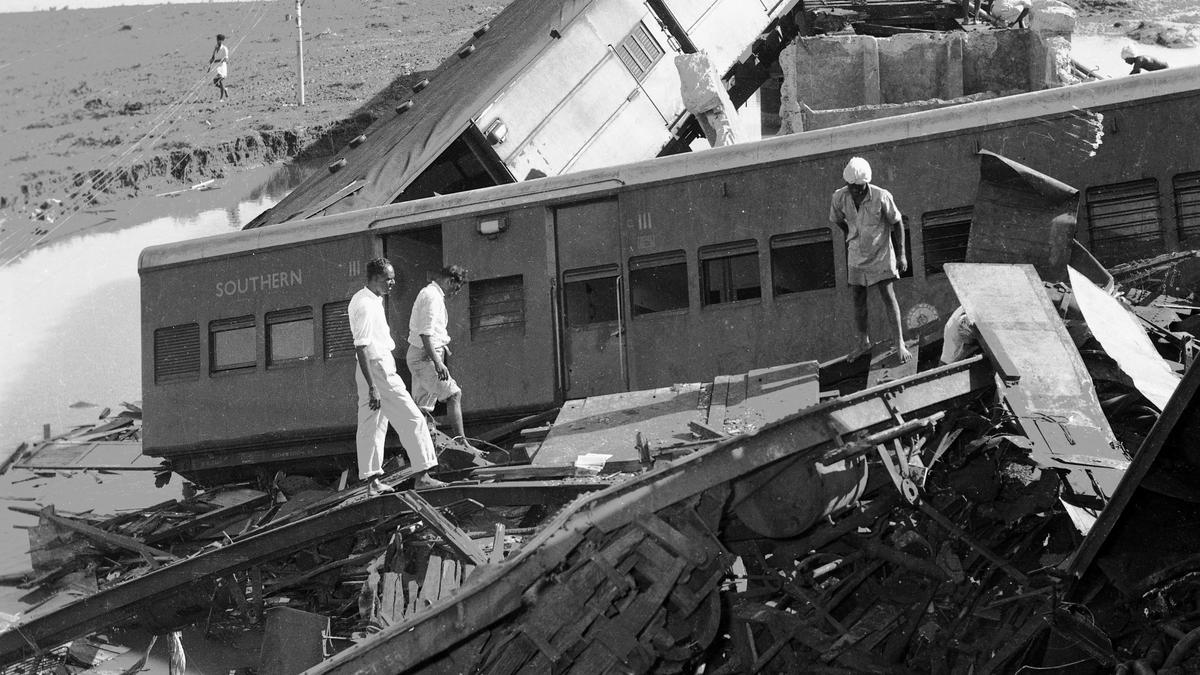
The train, which carried around 800 passengers, derailed while crossing the Maruthaiyaru. The river was in spate after heavy rain. The train’s engine and seven carriages plunged into the river.
| Photo Credit: THE HINDU ARCHIVES
On the night of November 22, 1956, the Thoothukudi Express (no. 803) left Madras for Thoothukudi. No one on the train knew then that what was about to happen would become a pivotal moment in Independent India’s history. Before dawn broke, the train, carrying around 800 passengers in 13 carriages, derailed while crossing the Maruthaiyaru in Ariyalur, claiming the lives of over 150 passengers and causing injuries to many more. Heavy rain had caused the river, three km from the Ariyalur station, to swell and almost touch the rails on a bridge between Ariyalur and Kallagam. The embankment was damaged to a length of nearly 20 feet, but four trains had already crossed the bridge. The Thoothukudi Express derailed around 5.30 a.m. Its engine and seven carriages plunged into the river.
Residents came to the rescue
Some carriages were fully submerged, trapping over 200 passengers. Many could not be rescued and some passengers jumped into the river and drowned. Residents of Sillakudi, Mettal, and Ariyalur, who woke up to a deafening noise, rushed to the scene to rescue the passengers. By the time rescue teams arrived from Tiruchi, scores of passengers had died. Sixty-eight years have passed, but the accident remains one of the worst in the Indian Railways’ history. Following the nationwide outrage, Railway Minister Lal Bahadur Shastri resigned.
C. Balakrishnan, 91, a Congress veteran of Ariyalur, was among the first to rush to the site. He was 23 then. Braving the floods, he trudged across the compartments to rescue as many survivors as possible. “It was horrible to see heaps of corpses in the rubble. Many were strewn and floating in the river and scores of survivors were screaming. It was not easy to rescue them against the surging waters. But some local residents, risking their lives, saved many before the rescue teams arrived. The pain was unbearable and the haunting memory continued to disturb my sleep for more than two weeks,” he recalls.
In her Open Page article published in The Hindu on May 19, 2016, Joyce Philomena Vernem, who survived the accident after a great ordeal, said it was one of the worst disasters that gripped the nation. “Being stranded there, waiting to be rescued with floodwaters on either side of the track, were the most frightening hours of my life, observing a scene a human eye could never have seen. It has haunted me all my life. The river bank was bathed in blood with human pulp, headless corpses, severed limbs, torsos, and heaps of bodies…,” she recounted in the article.
Anxious wait
Ms. Vernem, who was 21 years old then, a newly recruited clerk at the Golden Rock Railway School in Tiruchi, recalled that after an anxious wait of about four hours, the floodwaters receded. Finally, the river meekly meandered, and corpses bobbed in and out of water. The accident made the headlines for several days. It came in handy for the Opposition parties to target the Jawaharlal Nehru-led Congress government. Mr. Balakrishnan recalled that the DMK, which was in its formative years, spearheaded the protest in Tamil Nadu. “Ariyalur Alagesa! Nee Aandathu Pothatha, Makkal Mandathu Pothatha (Ariyalur Alagesan, isn’t your being in power enough, aren’t the death of people enough?)” was the slogan of the DMK protest, targeting O.V. Alagesan, who was the deputy to Shastri, holding the portfolios of Transport and Railways. Shastri spontaneously resigned, when many Congress leaders were against it.
“Accountability in public life dominates prime time debates whenever a high-profile rail accident occurs. The Opposition parties demand the resignation of the Minister concerned, seeking moral responsibility for the accident. Shastri’s gesture in 1956 raised the bar for accountability in public life. His resignation demonstrated a strong sense of responsibility and integrity. His legacy continues to inspire us and remind us of the importance of accountability in public life,” says M.M. Sivakumar, a Congress leader in Ariyalur. His father late Murugesan was among the first to respond to rescue the passengers.
Published – September 19, 2024 11:55 pm IST
